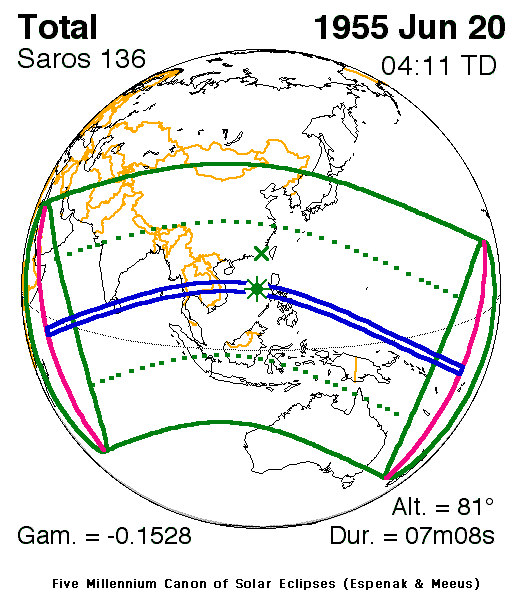Not all solar eclipses are equal – even if we’re ignoring partial and annual eclipses, some are more impressive sights than others. Part of the building excitement about next month’s North American eclipse is how much longer it will last than the 2017 equivalent, leading to questions like: when was the longest eclipse of all? And how long can an eclipse theoretically last?
The longest total eclipses are not what they once were – you might even say they are a shadow of their former selves. Once, eclipses could be much longer, and no doubt more fearsome, events. That, however, was millions of years ago when the Moon was closer to the Earth.
Even though the Moon hurried more quickly through its orbit back then, its extra apparent size meant it could block out the Sun even when it was not perfectly positioned in front. So if you want to go back to the days of the dinosaurs, there would have been some epic eclipses lasting longer than anything we get today.
Unfortunately, we don’t think there were any Ceratosaurus clockmakers to time the event. Moreover, our models of the movements of the celestial bodies, while impressive, lose accuracy the further back you go. We don’t know exactly when eclipses occurred tens of thousands – let alone millions – of years ago, so we can’t specify the dates of particularly long eclipses.
Therefore, any search for a record-breaker needs to be restricted to those someone measured, or at least were recorded as happening.
The longest precise measurement of a total eclipse comes from June 20, 1955, when the Sun was completely blocked for 7 minutes and 8 seconds. This eclipse was visible from Sri Lanka and parts of Southeast Asia, although most places on the path would have seen a somewhat shorter event.

There have been longer eclipses in history, but in 1955 we saw the longest totality (blue lines) humanity has had the capacity to measure.
That record won’t stand forever. In 2150, there will be an eclipse lasting 7 minutes and 14 seconds, so assuming we can keep civilization together until then it will become the longest by six seconds.
The 2150 eclipse’s time in the Sun will be fairly short, however. Eighteen years later, an eclipse will last a whopping 7 minutes 26; one three seconds longer still will occur in 2186 at 7 minutes 29 seconds. As we’ll see below, that is almost as long as an eclipse can be these days. The late 22nd century really will be a golden era for eclipse chasers, although the path of totality for the first of these barely touches land.
Humanity has probably witnessed eclipses longer than the one witnessed in 1955, however, even if we were not in a position to time them precisely. The oldest written record of an eclipse comes from the Chinese text the Shujing and is thought to refer to one on October 22, 2137 BCE, although Irish petroglyphs may refer to one 1,200 years earlier on November 30, 3340 BCE.
In that time there have been more than 20 that NASA has calculated exceeded the 1955 event. We don’t have records of all of them. For example, the eclipse of June 9, 1062, took place almost entirely over the Pacific Ocean, but according to modern calculations lasted 7 minutes and 20 seconds.
Relying on calculations alone, however, we can say that the longest in that period was in 743 BCE when part of the Indian Ocean was in darkness for 7 minutes 28 seconds. No doubt people in the areas where the path of the eclipse touched land were staggered by it, but they lacked the technology to measure it.
The length of an eclipse depends on the orbits of both the Earth and Moon, neither of which are perfectly circular. When the Earth is furthest from the Sun, our star takes up slightly less of the sky, and can therefore be entirely blocked for longer. Conversely, when the Moon is at its closest, it appears larger and can do more blocking. It also helps to be near the equator, to maximize the speed with which the Earth is turning the observer, slowing the relative speed of the Moon’s shadow. Eclipses are also longer when the Sun and Moon are almost directly above, rather than near the horizon.
Taking all these into account, the maximum length for an eclipse under current conditions, is said to be 7 minutes 31 seconds, according to calculations made by Isabel Martin Lewis of the US Naval Academy. Given how perfectly the celestial objects have to align, however, it’s not surprising we’re not aware of anything that long. Indeed, it’s amazing the examples listed above got as close as they did.
The factors Lewis identified help explain why next month’s eclipse, while far from a record, will be longer than most. The Earth’s distance from the Sun will be only slightly further than average, but the Moon will be only a day past perigee, or its nearest point to Earth. The path of totality starts quite close to the equator, although it ends quite far north, and for much of the way the Sun and Moon will be high in the sky.
In other words: of the four factors, this eclipse scores well on two and middling on the others. Those factors combine to give a maximum totality of 4 minutes 28 seconds, to be witnessed in Mexico. By comparison, 2017 wasn’t more than 2 minutes 40 seconds anywhere.
There are, of course, people who will try to extend eclipses by putting themselves in aircraft – even supersonic ones – to race the Moon’s shadow. Let us ignore such cheaters, however. If you’re that keen to keep the Moon between you and the Sun, join the Artemis Mission and do it properly.
Source Link: When Was The Longest Recorded Solar Eclipse In History?